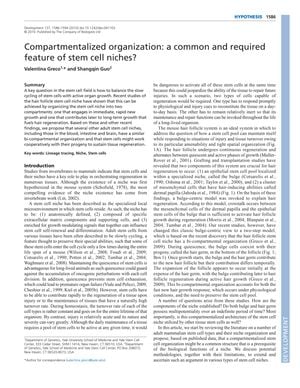Compartmentalized Organization: A Common and Required Feature of Stem Cell Niches?
April 2010
in “
Development
”
hair follicle stem cell niche bulge cells hair germ cells hematopoietic stem cells Bmi1-positive cells Lgr5+ crypt base columnar cells astrocytes lineage tracing Cre-recombinase-mediated lineage tracing niche environment stem cell identity stem cell states hair follicle stem cells hair growth cells blood stem cells intestinal stem cells brain cells Cre-recombinase tracing stem cell environment

TLDR Compartmentalized organization might be crucial for stem cells to effectively respond to growth or injury.
The document from May 15, 2010, explores the concept of compartmentalized organization within stem cell niches, using the hair follicle stem cell niche as a primary example. It suggests that this bi-compartmental organization, which separates immediate and long-term growth, may be a common feature in other adult stem cell niches, such as those in the blood, intestine, and brain. The hair follicle stem cell niche is described as having slow-cycling bulge cells for long-term growth and rapidly cycling hair germ cells for new growth. The document also discusses the presence of dormant and active hematopoietic stem cells in the bone marrow, Bmi1-positive cells and Lgr5+ crypt base columnar cells in the intestine, and two groups of astrocytes in the brain. It proposes that lineage tracing could be a useful tool to study these compartments in vivo. The document also addresses the limitations of Cre-recombinase-mediated lineage tracing, the influence of the niche environment on stem cell identity, and the potential interchangeability of stem cell states. It concludes that compartmentalized organization may be essential for stem cells to respond to growth or injury without depletion and acknowledges the need for rigorous experimental approaches to better understand the relationship between different compartments within stem cell niches.



